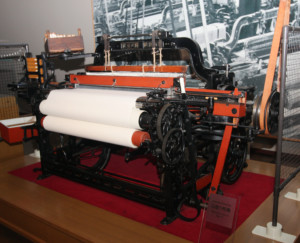 Toyota Motor originated from the Toyoda loom factory, where Sakichi Toyoda invented looms. Probably the most famous one is the Toyoda Model G Automatic Loom. This loom touches on many points that are part of the Toyota Production System and lean manufacturing. During my last visit to Japan in September, I made some videos detailing many of the features of the Toyoda Automatic Loom from 1924. Be advised: Lots of images and videos ahead!
Toyota Motor originated from the Toyoda loom factory, where Sakichi Toyoda invented looms. Probably the most famous one is the Toyoda Model G Automatic Loom. This loom touches on many points that are part of the Toyota Production System and lean manufacturing. During my last visit to Japan in September, I made some videos detailing many of the features of the Toyoda Automatic Loom from 1924. Be advised: Lots of images and videos ahead!
History
All postst related to the history of lean, management, manufacturing, and any other topic covered in this blog.
Hoshin Kanri and the Kanri Noryoku Program: Rejuvenating Toyota
How Cheap Can You Make it?
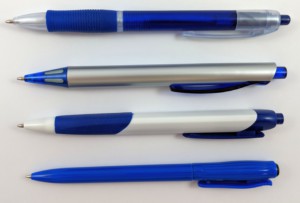 I was on a quest, a quest to find the cheapest ballpoint pen possible. And what I found was amazing. Modern manufacturing has achieved stunning productivity, where even a complex product like a ballpoint pen can be produced at costs that were unbelievable only a few decades ago. While everybody can make a pen, the goal in manufacturing is always to make it cheaper! For the same functionality, the customer will almost always go for the cheaper products. Let me show you the results of my quest.
I was on a quest, a quest to find the cheapest ballpoint pen possible. And what I found was amazing. Modern manufacturing has achieved stunning productivity, where even a complex product like a ballpoint pen can be produced at costs that were unbelievable only a few decades ago. While everybody can make a pen, the goal in manufacturing is always to make it cheaper! For the same functionality, the customer will almost always go for the cheaper products. Let me show you the results of my quest.
25 Years after W. Edwards Deming
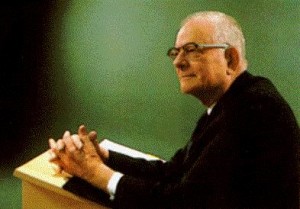 Twenty-five years ago today, William Edwards Deming (October 14, 1900 – December 20, 1993) passed away. He greatly influenced the management of quality in Japan, where he is still revered as one of the great gurus in manufacturing. Through his influence on Toyota, his ideas are now common in the lean world. Time to look back at his life.
Twenty-five years ago today, William Edwards Deming (October 14, 1900 – December 20, 1993) passed away. He greatly influenced the management of quality in Japan, where he is still revered as one of the great gurus in manufacturing. Through his influence on Toyota, his ideas are now common in the lean world. Time to look back at his life.
More on TWI Programs
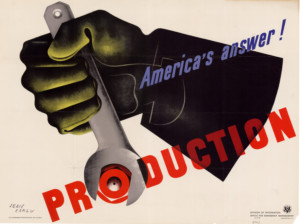 The TWI Program during World War II was very successful. Besides the Job Instructions, Job Methods, and Job Relations, a few other modules were developed, some of them internally. After the war, different institutions took over what the US government abandoned in December 1945. These follow-up institutions were the TWI Foundation and the TWI Inc. in the US; but it was also continued by the British TWI Service and the New Zealand TWI Service, and it was especially successful in Japan. Altogether, TWI was used in around seventy countries in 1960, although with quite different intensity and much less than when the US government used it through the war. This is the last in a series of five posts on TWI.
The TWI Program during World War II was very successful. Besides the Job Instructions, Job Methods, and Job Relations, a few other modules were developed, some of them internally. After the war, different institutions took over what the US government abandoned in December 1945. These follow-up institutions were the TWI Foundation and the TWI Inc. in the US; but it was also continued by the British TWI Service and the New Zealand TWI Service, and it was especially successful in Japan. Altogether, TWI was used in around seventy countries in 1960, although with quite different intensity and much less than when the US government used it through the war. This is the last in a series of five posts on TWI.
Where Lean Went Wrong – A Historical Perspective
 The Toyota Production System is widely considered to be the best production system for any larger company. Achieving similar performance is the vision (or dream?) of many companies. Pretty much all of lean manufacturing is the attempt to copy the approach of Toyota in the hope of a similar stellar performance. Yet most lean transformations fall way short of the goal. In this blog post I would like to give some insights, from a historical perspective, on why lean so often fails.
The Toyota Production System is widely considered to be the best production system for any larger company. Achieving similar performance is the vision (or dream?) of many companies. Pretty much all of lean manufacturing is the attempt to copy the approach of Toyota in the hope of a similar stellar performance. Yet most lean transformations fall way short of the goal. In this blog post I would like to give some insights, from a historical perspective, on why lean so often fails.
Material Flow in the Arsenal of Venice 1797
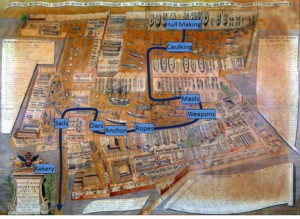 Whenever I am in Venice, I try to visit the Museo Storico Navale, near the entrance to the Arsenal of Venice. This museum has a set of beautiful detailed maps by Abbot Maffioletti showing the Arsenal of Venice in 1797, 1798, and “After Napoleon.” You can see in great detail the different steps needed to build and equip a sailing vessel. In this post, I will explain the material flow of the Arsenal of Venice, which was the largest industrial site in Europe and possibly in the world during its time. Be warned, this post is rich in images. The material flow is partially based on the master thesis of my student Maren-Linn Janka.
Whenever I am in Venice, I try to visit the Museo Storico Navale, near the entrance to the Arsenal of Venice. This museum has a set of beautiful detailed maps by Abbot Maffioletti showing the Arsenal of Venice in 1797, 1798, and “After Napoleon.” You can see in great detail the different steps needed to build and equip a sailing vessel. In this post, I will explain the material flow of the Arsenal of Venice, which was the largest industrial site in Europe and possibly in the world during its time. Be warned, this post is rich in images. The material flow is partially based on the master thesis of my student Maren-Linn Janka.
The Arsenal of Venice
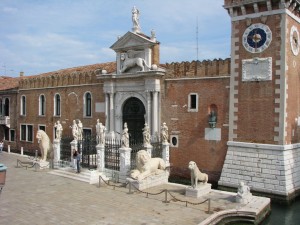
The Arsenal of Venice was one of the the largest industrial sites in Europe in the 16th century. This was the hub of Venetian ship building, supporting the power of the Venetian republic. Both warships and merchant vessels were built there.
It is also known for the organization of its work. Sometimes it is listed as the world’s first assembly line, although in my view this may be a bit of a stretch. While they achieved a lot, there was also a lot of chaos. In this post I present you with a bit about the Arsenal in general, as well as some detailed maps by Abbot Maffioletti from 1797 and 1798. In my next post I will go into much more detail on the material flow based on these maps.

